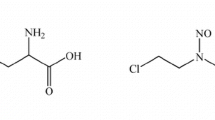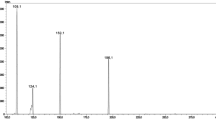Abstract
A novel assay method for the determination of atropine in biological fluids is presented. Atropine is extracted and subsequently hydrolyzed. The generated tropine is then derivatized to heptafluorobutyryl-tropine, which is measured by GLC-MS. Base peaksm/z 124 andm/z 127 are simultaneously monitored. Deuterated atropine serves as internal standard. This specific and sensitive assay permits a delineation of the disposition pharmacokinetics in humans after i.v. administration of the drug.
Prepharmacokinetic studies determined pK a values for atropine and tropine of 9.56 and 10.35 respectively at 22°C. Solvent partitioning experiments showed that atropine exerts a significantly larger lipophilicity than tropine. This was consistent with the observed higher plasma protein binding and erythrocyte buffer partitioning of atropine (12%, 1.2) compared with tropine (0%, 0.85) at 37°C and pH 7.4. Plasma protein binding and erythrocyte partitioning of both compounds were concentration independent and invariable in the presence or absence of each other.
Similar content being viewed by others
References
L.S. Goodman andA. Gilman,The Pharmacological Basis of Therapeutics 5th edn., p. 516. The MacMillan Company, New York 1977.
M. Tønnesen,The excretion of atropine and allied alkaloids in urine, Acta Pharmac.6, 147–164 (1950).
R.E. Gosselin, J.D. Gabourel andJ.H. Wills,The fate of atropine in man, Clin. Pharmac. Ther.1, 597–603 (1960).
S.C. Kalser The fate of atropine in man, Ann. N.Y. Acad. Sci.179, 667–683 (1971).
S.C. Kalser,andP.L. McLain,Atropine metabolism in man, Clin. Pharmac. Ther.11, 214–227 (1970).
R.J. Wurzburger, R.L. Miller, H.G. Boxenbaum andS. Spector,Radio immunoassay of atropine in plasma, Exp. Ther.203, 435–441 (1977).
W.F. Bayne, F.T. Tao andN. Crisologo,Submicrogram assay for scopolamin in plasma and urine, J. Pharm. Sci.64, 288–291 (1975).
L.S. Goodman andA. Gilman,The Pharmacological Basis of Therapeutics, 5th edn, p. 515. The MacMillan Company, New York 1977.
G.C. Schmidt, T.E. Eling andJ.C. Drach,Synthesis of tropine labelled atropine I, micromethods for the synthesis of tropine and for its esterification with tropic acid, J. Pharm. Sci.56, 215–221 (1976).
F. Blicke, H. Raffelson andB. Barna,The preparation of tropic acid, J. Amer. Clin. Soc.74, 253 (1952).
J. Van de Kamp andMeyer Sletzinger,Production of tropine, U.S. Patent Office, U.S. Pat. 2,366,760 (1945).
A. Stoll, E. Jucker andA. Lindemann,Process for the preparation of alkoxy-tetrahydrofuranes, U.S. Patent Office, U.S. Pat. 2,746,976 (1956).
A. Albert andE.P. Serjeant,The Determination of Ionization Constants, p. 9, Chapman and Hall, London 1971.
A. Albert andE.P. Serjeant,The Determination of Ionization Constants, p. 281. Chapman and Hall, London 1971.
P.H. Hinderling, J. Brès andE.R. Garrett,Protein binding and erythrocyte partitioning of disopyramide and its monodealkylated metabolite, J. Pharm. Sci.,63, 1684–1690 (1974).
P.H. Hinderling,Comparative studies of the protein binding of digoxin and its metabolites, Agents and Actions7, 379–382 (1977).
A. Roos andP.H., Hinderling,Protein binding and erythrocyte partitioning of the antirheumatic proquazone, J. Pharm. Sci. (in press).
L.T. Skeggs Jr andH. Hochstrasser,Multiple automatic sequential analysis, Clin. Chem.,10, 918–936 (1964).
C.B. Laurell,Quantitative estimation of proteins by electrophoresis in agarose gel containing antibodies, Analyt. Biochem.15, 45–50 1966.
Documenta Geigy, 7th edn (EdsK. Diem andC. Lentner), p. 582. Ciba-Geigy Corporation, Ardsley, New York 1975.
P. Zwirblis, J. Socholitsky andA. Kondritzer,The kinetics of the hydrolysis of atropine. J. Am. Pharmaceut. Ass. Sci. Ed.45, 450–454 1956.
A. Albert andE.P. Serjeant,The Determination of Ionization Constants, p. 18, Chapman and Hall, London 1971.
L.S. Schanker, P.A. Nafpliotis andJ.M. Johnson,Passage of organic bases into human red cells, J. Pharmac. Exp. Therap.113, 325–331 1961.
U. Abshagen, H. Kewitz andN. Rietbrock,Distribution of digoxin, digitoxin and ouabain between plasma and erythrocytes in various species,. Naunyn-Schmiedebergs Arch. Pharmak.270, 105–116 (1971).
W. Dieterle, J. Wagner andJ.W. Faigle,Binding of chlorthalidone (Hygroton ®)to blood components in man, Eur. J. Clin. Pharmac.10, 37–42 (1976).
B.D. Davis,The binding of sulfonamide drugs by plasma proteins. A factor in determining the distribution of drugs in the body, J. Clin. Invest.22, 753–762 (1943).
M. Gibaldi andD. Perrier,Pharmacokinetics,. p. 45. Marcel Decker, New York 1975.
D.S. Riggs,The Mathematical Approach to Physiological Problems, p. 146. Williams and Wilkins, Baltimore 1963.
J.M. Kolthoff,Die Dissoziationskonstante, das Löslichkeitsprodukt und die Titrierbarkeit von Alkaloiden, Biochem. Z.162, 289–353 (1925).
F. Müller,Die Potentiometrische Bestimmung von Alkaloiden an der Wasserstoffelektrode, Z. für Elektrochemie30, 587–600 (1924).
The Merck Index, 9th edn. Merck and Co. Rahway 1968
A. Alberti,Ionization, pH and biological activity, Pharmac. Review4, 136–167 (1952).
E. Krüger-Thiermer,Dosage schedule and pharmacokinetics in chemotherapy, J. Am. Pharmaceut. Ass. Sci. Ed.49, 311–313 (1960).
P. Spring,Die Bindung einiger Sulfanilamide an die Bluteiweisskörper des Menschen, Drug Res.16, 346–354 (1966).
P. Kramer, E. Köthe.,J. Saul andF. Scheler,Uraemic and normal plasma protein binding of various cardiac/glycosides under ‘in vivo’ conditions, Eur. J. Clin. Invest.4, 53–58 (1974).
M. Tønnesen,On the absorption of atropine to plasma proteins, Acta pharmacol. et toxicol.12, 247–250 (1956).
J. Judis,Binding of amphetamine, atropine, epinephrine and histamine to human serum proteins, Can. J. Pharm. Sci.14, 46–50 (1979).
Author information
Authors and Affiliations
Rights and permissions
About this article
Cite this article
Eckert, M., Hinderling, P.H. Atropine: A sensitive gas chromatography—mass spectrometry assay and prepharmacokinetic studies. Agents and Actions 11, 520–531 (1981). https://doi.org/10.1007/BF02004716
Received:
Issue Date:
DOI: https://doi.org/10.1007/BF02004716




